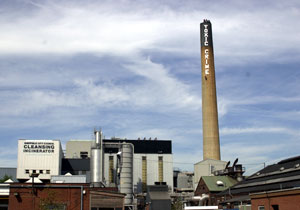
An analysis of votes cast in the local elections in Sheffield on May 2nd reveals that opposition to a new incinerator in the city may have swung two key wards from the Liberal Democrats to Labour. The swing resulted in the Liberal Democrats losing control of the city - a stark contrast to the situation in Hull where the Liberal Democrats were opposed to incineration and enjoyed massive electoral success. The poll analysis was conducted by Friends of the Earth and Greenpeace and is attached.
Commenting on the poll analysis, Mark Strutt, head of the incineration campaign at Greenpeace, said:
"It's very clear that the new incinerator at Bernard Rd was a significant factor in the Sheffield result. If the Sheffield Liberal Democrats had followed the line from their national office and opposed incineration they would still be in control of the city."
Mike Childs, head of the toxics campaign at Friends of the Earth, said:
"The proposal for an incinerator in Sheffield clearly influenced the outcome of the local elections. The Council clearly now has a duty to rethink its plans for a massive incinerator in Sheffield. People in Sheffield don't want incineration and certainly don't want to be the dustbin for the rest of South Yorkshire. There are other options and we hope the Council will begin to look at these seriously."
Poll analysis
Sheffield local election results - May 2002
Until 2 May 2002, the Liberal Democrats, who had more than half of the council seats, controlled Sheffield City Council. At the election, Labour took seven seats to become the largest party, through remained just short of an overall majority - the balance of seats is now Labour 43, Liberal Democrat 42 and Conservative 2.
There are good reasons for believing that the Liberal Democrats' support for a new waste incinerator at Bernard Rd in Sheffield cost them votes at the election. It may even have cost them control of the council. The evidence is set out below.
The Green vote
The Green Party stood in 13 wards, mostly in central and south Sheffield, and used their opposition to the new Bernard Rd incinerator as a central plank of their campaign. An anti-incinerator candidate also stood in the Beauchief ward. Green candidates gained between 2.5% of the votes cast (in Dore) and 17% (in Netherthorpe). On average, their candidates gained 8% of the votes cast - twice as many as previously. The anti-incinerator candidate gained 4% of the vote - despite standing only as an independent, and therefore not being identifiable as "anti-incinerator" on the ballot paper. See the spread of votes for green or anti-incinerator candidates here.
The doubling in the Green vote in Sheffield also needs to be seen in the context of falling Green votes across the country as a whole. The Green's lost councillors overall, including 5 in Oxford, and 2 in Hackney.
Key seats analysis
The Lib Dems lost 5 seats to Labour in the election. Labour also gained one vacant seat, and one from a retiring independent councillor. Had the Liberal Democrats held onto just one of the seats they lost to Labour, they would have had more councillors than Labour but been just short of an overall majority on the council. Holding onto two seats would have left them retaining overall control. The wards that changed hands are below.
| Ward | Labour | Lib Dems | Conservative | Green | Other | Labour majority |
| Birley | 2775 | 1723 | 282 | 1052 | ||
| Heeley | 1878 | 1476 | 229 | 496 | 186 | 402 |
| Hillsborough | 2019 | 1434 | 415 | 237 | 106 | 585 |
| Intake | 2213 | 1460 | 325 | 143 | 753 | |
| Norton | 1714 | 1341 | 360 | 150 | 373 | |
| Owlerton | 2137 | 365 | 207 | 54 | 1772 | |
| Walkley | 1846 | 1735 | 208 | 471 | 111 |
The table above shows that in Walkley, had the Liberal Democrats attracted the support of less than a quarter of the people who voted Green, they would have kept the seat, and thus remained the largest party on the council.
In Heeley too, the Green vote exceeded the Lib Dems losing margin, though here around 80% of Greens would have been required to switch to the Liberal Democrats to save the seat.
In addition to missing out on these direct transfers, a strong anti-incinerator campaign could also have attracted support from the other parties as well, and encouraged some of the stay-at-home voters out to vote as well.
Comparisons with other councils
In Hull, Liberal Democrats campaigned against the Labour Council's decision to build an incinerator. In the election, the Liberal Democrats trounced Labour candidates, and became the biggest group on the council, following more than 40 years of a Labour controlled council.
Prior to the election, Labour held 44 seats, the Lib Dems 10 (there were also 2 Conservatives and 4 Independents). Following the vote, there were 29 Lib Dems and 24 Labour. Almost half of Labour held seats went to the Lib Dems.
Further information:
Contact:
The Greenpeace press office on 020 7865 8255 or
Friends of the Earth press office on 020 7566 1694

